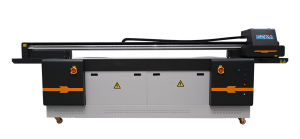
Introduce the wide application of UV printers in industries such as advertising, decoration, and packaging. Highlight the crucial impact of production efficiency on enterprise cost control, order delivery, and market competitiveness.
Elaborate on the influence of the quality and quantity of print heads, as well as the type of print heads (such as Epson print heads and Ricoh print heads) on the printing speed. Explain the role of high – precision guide rails and a stable steel frame structure in ensuring the stability of the printing process, and how stable operation guarantees efficiency.
Explain the speed differences among different printing modes (such as draft, production, high – precision, and ultra – high – precision modes). Illustrate the speed advantage of two – way printing over one – way printing. Explain how software settings affect data transmission and the execution speed of printing commands.
Analyze how the fluidity and drying speed of high – quality inks contribute to the continuity of printing. Explain how the flatness and adaptability of high – quality printing materials reduce issues such as paper jams and inaccurate positioning that affect efficiency.
Elaborate on the significance of standard operating procedures, such as proper startup and shutdown, loading and unloading, for the stable operation of the equipment. Emphasize the importance of regular maintenance tasks, such as cleaning the print heads and rollers, and checking the equipment components, in reducing malfunctions and maintaining efficiency.
Cite practical cases where the printing speed has been increased after upgrading from civilian – grade print heads to industrial – grade print heads or increasing the number of print heads. Share experiences of upgrading computer hardware configurations to improve data transmission and graphics processing speeds, thereby enhancing overall efficiency.
Provide specific suggestions on selecting appropriate printing modes according to different printing tasks. Introduce how to enable the two – way printing function and other optimization settings in the software.
Recommend high – quality ink and printing material brands that have been verified in practice. Explain the negative impacts on efficiency, such as print head clogging and decreased printing quality, caused by using inferior consumables.
Provide a detailed daily operation specification and maintenance plan for UV printers. Emphasize the importance of operator training and the establishment of a maintenance record file to help detect and solve problems in a timely manner.
Describe how to conduct batch production according to the type and quantity of orders, reducing the number of equipment adjustments and consumable replacements. Introduce successful cases of achieving continuous production by using automated production lines or auxiliary molds.
Based on the characteristics of small studios, such as small business volume and personalized orders, provide targeted suggestions for selecting suitable small – scale UV printers and improving efficiency. For example, choose equipment that is easy to operate and highly flexible, and utilize the personalized settings of the software to meet diverse needs.
For large – scale enterprises with large order volumes and large – scale production requirements, explain how to configure large – scale UV printers and supporting automated equipment to achieve high – efficiency production. For example, adopt multi – print – head, large – format equipment, and be equipped with automated loading and unloading systems.
Summarize the factors affecting the production efficiency of UV printers and the improvement strategies. Emphasize the importance of continuously paying attention to technological development and equipment optimization for maintaining high – efficiency production. Look ahead to the trends in the improvement of UV printer production efficiency in the future.